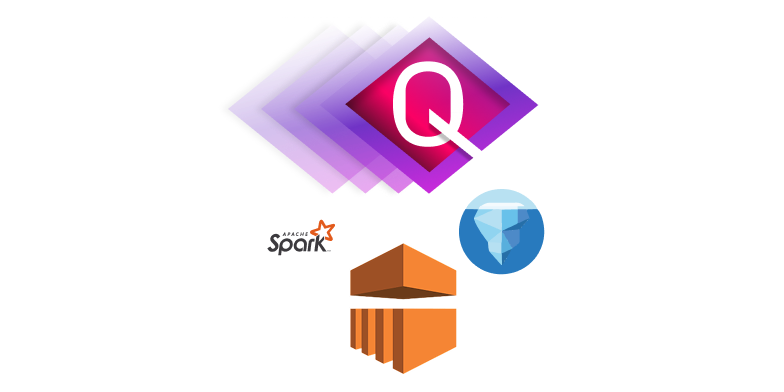Data Lake vs. Warehouse vs. Lakehouse

As modern organizations collect huge amounts of data, there’s a growing need for innovative ways to manage and analyze it. Some of the most common data storage solutions that organizations use to handle such large amounts of data include:
- Data warehouse: A centralized repository that stores data in a relational structure. It's the oldest type of data storage architecture and is designed for fast query performance and supports complex analytical workloads by integrating data from multiple systems. Data can be loaded through an ETL process to ensure consistency and quality.
- Data lake: A centralized repository that can store any type of data, including structured, unstructured, and semi-structured data. It can handle large volumes of raw data at scale, stored in its native format until needed. Data lakes support advanced analytics, machine learning, and real-time processing by leveraging distributed computing frameworks.
- Data lakehouse: A hybrid architecture that combines the best of both worlds: the structured data management of the data warehouse and the flexibility of the data lake. It enables ACID transactions and schema enforcement on data stored in open formats, thus bridging the gap between analytical and machine learning workloads. Data lakehouses reduce data duplication and movement. They are often implemented using technologies like Apache HudiTM , Apache IcebergTM, and Delta Lake.
Choosing the wrong solution can lead to ballooning storage costs, slow query performance, and fragmented data workflows. That’s why it’s essential to understand how different architectures compare, not just in what they store, but in how they handle performance, flexibility, and interoperability. You need to consider the data types the storage solution supports as well as its query performance and analytics capabilities, scalability and cost, openness and interoperability, and use cases. This article explores their differences and similarities so you can pick the one that best suits your particular needs.
Supported Data Types
One of the key areas where these storage architectures differ is the data types they support:
- Data warehouses: The classic data warehouse can usually store only structured data, which is data that has a standardized format and a fixed schema. The schema is specified before the data is loaded, so this is commonly referred to as a “schema-on-write” pattern. Such data generally comes in a tabular format and can fit in rows and columns. For example, a company can store data about its customers, such as their names, phone numbers, or email addresses, in a tabular format. Data warehouses are highly efficient when it comes to storing and retrieving such data. This is because they use columnar storage to improve compression and speed up analytical queries. In addition, data warehouses enforce a predefined schema, which ensures the data is organized for efficient retrieval.
- Data lakes and lakehouses: Data lakes and lakehouses can store basically any type of data, including structured, unstructured, and semi-structured data. Unlike structured data, unstructured data doesn’t have a standardized format. Such data usually can’t be stored in a simple tabular format, which makes it more difficult to organize and process. Examples of unstructured data include images, videos, audio files, text files, and similar. Data lakes use a schema-on-read approach, which allows them to store unstructured data in its raw form. To support this flexibility, they typically rely on distributed file systems or object storage, offering scalable, low-cost storage in open file formats such as Apache ParquetTM and Apache ORCTM. Like data lakes, lakehouses use the same underlying storage systems, such as AWS S3. They support both columnar and row-based file formats, including Apache Parquet, ORC, and Avro. This enables them to store a wide range of structured, semi-structured, and unstructured data efficiently.
While data lakes are highly flexible, they can be less organized given the absence of enforced schema. Lakehouses, on the other hand, offer both the flexibility of data lakes and the reliability and performance features of data warehouses, reducing the need for a separate warehouse layer. This unified architecture helps you avoid the cost overheads and unmanageable data copies issue seen in traditional two-tiered systems. As a result, many organizations are moving toward lakehouses to simplify operations.
Query Performance and Analytics Capabilities
Data warehouses, data lakes, and data lakehouses differ significantly in how they handle queries and analytics:
- Data warehouses: Data warehouses are limited in terms of supported data types, but they really shine when it comes to query performance and analytics capabilities. When you store data in a warehouse, the data is immediately cleaned, organized, and structured with a defined schema. Data warehouses can achieve high performance thanks to indexing (which helps speed up data retrieval), materialized views (to store precomputed query results), query optimization (which enhances execution efficiency), and columnar storage formats (which allow for efficient data scanning).
- Data lakes: While data lakes support various data types, their query performance and analytics capabilities are very limited. Data in lakes isn’t preprocessed or indexed, and it doesn’t have a predefined schema. In addition, performance issues come from challenges like the small file problem, large metadata overhead, and ineffective partitioning. The lack of table management features, such as compaction and clustering, also leads to disorganized storage layouts and inefficient data retrieval and querying. Other challenges data lakes face include data quality issues (since raw data is of lower quality) and the need for specialized tools to process and analyze the data, such as Apache SparkTM or Hive.
- Data lakehouses: Like data lakes, data lakehouses support various data types, but they also offer the fast querying and analytics capabilities of data warehouses. To make that possible, lakehouses implement performance optimization features such as partitioning, clustering, compaction, and data skipping (which avoids scanning irrelevant data), and, in some cases, indexing. Caching of frequently accessed data can further enhance query speeds, making lakehouses suitable for both real-time analytics and large-scale batch processing.
Generally, if you don’t need flexibility in terms of supported data types, a data warehouse will provide the best performance, though proprietary systems may be cost-prohibitive at scale. On the other hand, because of their structure and variety of formats, data lakes require additional tools for effective querying and analysis. Data lakehouses, once again, offer a balanced solution between the two.
For example, a data lakehouse would suit a streaming service handling structured user profiles, semi-structured metadata such as watch history, and high-frequency updates like user activity logs. Apache Hudi supports this through optimized ingestion of CDC data from sources like MySQL or Kafka, enabling efficient, real-time analytics. By combining schema enforcement, indexing, and caching, a lakehouse ensures quick data retrieval and analysis without the limitations of a traditional data lake. For even better performance, Onehouse’s Universal Data Lakehouse offers a fully managed solution that uses automated table maintenance and optimized compute to accelerate queries on data lakehouses. This results in queries that are up to thirty times faster.
Scalability and Cost
These storage architectures also take different approaches to scalability and cost. Choosing the wrong solution for your use case could lead to rapidly increasing costs as you scale.
- Data warehouses: Data warehouses can be scaled, but this comes at a cost. They’re optimized for query performance, which in turn makes them more computationally intensive. While this works on a smaller scale, as the amount of data grows, the costs can significantly increase, meaning data warehouses can be very expensive for large data sets. In addition, storage costs can accumulate, particularly with multiple data copies and reliance on premium storage systems. Warehouses also often rely on proprietary hardware and licensing fees, whose costs can be significant on a large scale.
- Data lakes: Data lakes use very cheap storage solutions and don’t require processing when you load the data. They often use object stores and a pay-as-you-go pricing model. As such, they are highly scalable and extremely cost-effective, even for huge data sets. But if you want to process and consume the data, the costs can increase.
- Data lakehouses: Data lakehouses fall somewhere between data lakes and warehouses when it comes to scalability and cost. They have features like indexing, caching, and schema enforcement, which not only improve query speed and reliability but also reduce compute costs by limiting the amount of data scanned. A good lakehouse platform finds ways to optimize for both scalability and cost; for example, Onehouse provides automatic table optimization services, scheduled maintenance operations, and advanced cleaning tools that reduce storage overhead, improve performance, and minimize compute costs.
Before choosing the right solution for you, you need to consider the scalability and cost. Data warehouses are a good option for high-performance query needs, but they can become expensive with lots of data. Data lakes are much more cost-effective. Finally, data lakehouses provide both good scalability and performance.
Openness and Interoperability
The storage architectures’ different levels of openness and interoperability affect how easily they integrate with various tools and platforms:
- Data warehouses: Data warehouses are not an optimal choice for openness; they’re usually built on proprietary technologies. For example, cloud warehouses such as Amazon Redshift or Google BigQuery use proprietary storage formats, which lock data into specific ecosystems. Such platforms often require vendor-specific tools for querying and management, limiting your flexibility. In addition, migrating data between warehouses can be costly and complex, as there are differences in the architectures.
- Data lakes: Data lakes support many different formats, such as JSON, CSV, and Parquet. These open source formats can be used across different platforms and tools without vendor restrictions, which is often not the case with proprietary formats that might require specialized software to process the data. This openness ensures interoperability and allows for seamless data sharing. Data lakes also support integration with many different external tools as well as data processing and analytics frameworks, such as Apache Spark and Hive.
- Data lakehouses: Data lakehouses are similarly great when it comes to openness and interoperability since they support open storage formats (file and table formats) as well. This open and independent data tier allows lakehouses to integrate with any query engine that's compatible with the storage formats, enabling multi compute support on the same set of data. For example, Onehouse’s Universal Data Lakehouse can work with multiple table formats and catalogs. It offers interoperability across multiple table formats, including Apache Hudi, Apache Iceberg, and Delta Lake. It uses Apache XTable (incubating), which allows you to work across different table formats without being locked into a specific ecosystem.
In general, if you require openness and the ability to work with diverse data formats and tools, a data lake or lakehouse is a better choice compared to a data warehouse. These also support a much wider range of open source tools, frameworks, and platforms, and they offer more freedom and adaptability in general.
Use Cases
Now that you’ve compared the different data architectures and features, let’s look at some specific use cases they’re best suited for:
- Data warehouses: Data warehouses are particularly useful for data analysis, business intelligence, and reporting purposes in fields such as finance, retail, and healthcare, which rely on structured data sets. With strong SQL support, data warehouses make it easy to query and retrieve data from multiple sources, create dashboards, and generate reports for data-driven decision-making. Business and data analysts are among the most common users of data warehouses.
- Data lakes: Data lakes are frequently used in machine learning, AI, and any use case that requires big data storage. As data lakes allow you to store large amounts of diverse data, they also work well in industries such as technology or e-commerce. Professionals who commonly work with data lakes include data scientists, machine learning engineers, and big data engineers.
- Data lakehouses: Data lakehouses can typically be used for any use case, including those mentioned above. They provide the performance and structure of a data warehouse combined with the flexibility and scalability of a data lake. The versatility of data lakehouses makes them a good choice for a variety of professionals, including data analysts, data scientists, machine learning engineers, and many more.
The right choice depends on your specific needs. So, consider whether your use case needs to prioritize structured analytics, large-scale data storage, or a balance of both.
Overview
Here’s a quick comparison of the key features across data warehouses, data lakes, and data lakehouses:
Conclusion
This article compared data warehouses, data lakes, and data lakehouses, highlighting that each has its strengths. Data warehouses excel in query performance and analytics capabilities, but come at a high cost and low flexibility (closed ecosystem). Data lakes offer scalability, cost-effectiveness, and support for all types of data, but querying them can be complex and inefficient. Data lakehouses, the newest architecture, combine the strengths of both data warehouses and lakes to provide a hybrid solution with the best of both worlds. They offer the scalability and openness of data lakes alongside the performance and advanced data management features of warehouses, such as ACID transactions, schema evolution, time travel, and support for updates and deletes. With their open architecture, cost efficiency, and ability to support diverse analytical workloads, data lakehouses present a flexible and future-ready solution for modern data needs.
Onehouse’s Universal Data Lakehouse can pull data from any source and transform, manage, and query it. Onehouse also offers managed services such as Onehouse Cloud, LakeView, and the Lakehouse Table Optimizer. It’s also the company behind Hudi, a pioneering lakehouse technology. Hudi, which is now used industry-wide, was originally created by Onehouse’s founder and CEO. It enables incremental processing, flexible indexing, intelligent data optimization, and advanced data auditing and processing.
Try the OneHouse Universal Data Lakehouse with $1,000 in free credits.
Read More:
Subscribe to the Blog
Be the first to read new posts








